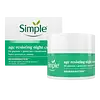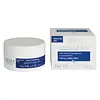What's inside
What's inside
 Key Ingredients
Key Ingredients

 Benefits
Benefits

 Concerns
Concerns

 Ingredients Side-by-side
Ingredients Side-by-side

Water
Skin ConditioningC12-15 Alkyl Benzoate
AntimicrobialBehenyl Behenate
EmollientGlycerin
HumectantSqualane
EmollientButylene Glycol
HumectantCetyl Palmitate
EmollientPolyhydroxystearic Acid
EmulsifyingPolyglyceryl-10 Stearate
Skin ConditioningPanthenol
Skin ConditioningDimethicone
EmollientPhenoxyethanol
PreservativeCarbomer
Emulsion StabilisingEuphorbia Cerifera Cera
AstringentSodium Stearoyl Lactylate
EmulsifyingTocopheryl Acetate
AntioxidantSodium Hydroxide
BufferingEthylhexylglycerin
Skin ConditioningPentylene Glycol
Skin ConditioningSerine
MaskingSodium Lactate
BufferingLactic Acid
BufferingUrea
BufferingFomes Officinalis Extract
Skin ProtectingSorbitol
HumectantPantolactone
HumectantPEG-40 Hydrogenated Castor Oil
EmulsifyingBisabolol
MaskingBorago Officinalis Seed Oil
EmollientSodium Chloride
MaskingPropylene Glycol
HumectantAllantoin
Skin ConditioningCamellia Sinensis Leaf Extract
AntimicrobialWater, C12-15 Alkyl Benzoate, Behenyl Behenate, Glycerin, Squalane, Butylene Glycol, Cetyl Palmitate, Polyhydroxystearic Acid, Polyglyceryl-10 Stearate, Panthenol, Dimethicone, Phenoxyethanol, Carbomer, Euphorbia Cerifera Cera, Sodium Stearoyl Lactylate, Tocopheryl Acetate, Sodium Hydroxide, Ethylhexylglycerin, Pentylene Glycol, Serine, Sodium Lactate, Lactic Acid, Urea, Fomes Officinalis Extract, Sorbitol, Pantolactone, PEG-40 Hydrogenated Castor Oil, Bisabolol, Borago Officinalis Seed Oil, Sodium Chloride, Propylene Glycol, Allantoin, Camellia Sinensis Leaf Extract
Water
Skin ConditioningCaprylic/Capric Triglyceride
MaskingGlycerin
HumectantDicaprylyl Carbonate
EmollientCetearyl Alcohol
EmollientCetearyl Glucoside
EmulsifyingEthylhexyl Stearate
EmollientPanthenol
Skin ConditioningGlyceryl Stearate
EmollientGlyceryl Stearate Citrate
EmollientTocopheryl Acetate
AntioxidantLecithin
EmollientUbiquinone
AntioxidantPropylene Glycol
HumectantHelianthus Annuus Seed Oil
EmollientGlycine Soja Seed Extract
Skin ConditioningTriticum Vulgare Germ Extract
Skin ConditioningRetinyl Palmitate
Skin ConditioningRetinol
Skin ConditioningPersea Gratissima Oil
Skin ConditioningCarthamus Tinctorius Seed Oil
MaskingGlycine Soja Oil
EmollientGlycine Soja Sterols
EmollientC12-15 Alkyl Benzoate
AntimicrobialDimethicone
EmollientLinoleic Acid
CleansingLinolenic Acid
CleansingTocopherol
AntioxidantSodium Cetearyl Sulfate
CleansingSodium Hyaluronate
HumectantHexyl Laurate
EmollientAscorbic Acid
AntioxidantParfum
MaskingAscorbyl Palmitate
AntioxidantGlyceryl Oleate
EmollientDimethylmethoxy Chromanol
AntioxidantCitric Acid
BufferingSodium Hydroxide
BufferingHydrogenated Palm Glycerides Citrate
EmollientPropanediol
SolventAlcohol
AntimicrobialSorbitol
HumectantPhenoxyethanol
PreservativeAlcohol Denat.
AntimicrobialBenzoic Acid
MaskingDehydroacetic Acid
PreservativeSodium Benzoate
MaskingPotassium Sorbate
PreservativeSorbic Acid
PreservativeBenzyl Alcohol
PerfumingBHT
AntioxidantWater, Caprylic/Capric Triglyceride, Glycerin, Dicaprylyl Carbonate, Cetearyl Alcohol, Cetearyl Glucoside, Ethylhexyl Stearate, Panthenol, Glyceryl Stearate, Glyceryl Stearate Citrate, Tocopheryl Acetate, Lecithin, Ubiquinone, Propylene Glycol, Helianthus Annuus Seed Oil, Glycine Soja Seed Extract, Triticum Vulgare Germ Extract, Retinyl Palmitate, Retinol, Persea Gratissima Oil, Carthamus Tinctorius Seed Oil, Glycine Soja Oil, Glycine Soja Sterols, C12-15 Alkyl Benzoate, Dimethicone, Linoleic Acid, Linolenic Acid, Tocopherol, Sodium Cetearyl Sulfate, Sodium Hyaluronate, Hexyl Laurate, Ascorbic Acid, Parfum, Ascorbyl Palmitate, Glyceryl Oleate, Dimethylmethoxy Chromanol, Citric Acid, Sodium Hydroxide, Hydrogenated Palm Glycerides Citrate, Propanediol, Alcohol, Sorbitol, Phenoxyethanol, Alcohol Denat., Benzoic Acid, Dehydroacetic Acid, Sodium Benzoate, Potassium Sorbate, Sorbic Acid, Benzyl Alcohol, BHT
 Reviews
Reviews

Ingredients Explained
These ingredients are found in both products.
Ingredients higher up in an ingredient list are typically present in a larger amount.
C12-15 Alkyl Benzoate is made up of Benzoic Acid and long chain alcohols. It has a low molecular weight.
C12-15 Alkyl Benzoate is an emollient and texture enhancer. Due to its solubility, it is often used in sunscreens to help evenly distribute active ingredients.
As an emollient, C12-15 Alkyl Benzoate helps soften and hydrate your skin. Emollients create a film on your skin that traps moisture within.
This ingredient has been reported to cause eye irritation.
Learn more about C12-15 Alkyl BenzoateDimethicone is a type of synthetic silicone created from natural materials such as quartz.
What it does:
Dimethicone comes in different viscosities:
Depending on the viscosity, dimethicone has different properties.
Ingredients lists don't always show which type is used, so we recommend reaching out to the brand if you have questions about the viscosity.
This ingredient is unlikely to cause irritation because it does not get absorbed into skin. However, people with silicone allergies should be careful about using this ingredient.
Note: Dimethicone may contribute to pilling. This is because it is not oil or water soluble, so pilling may occur when layered with products. When mixed with heavy oils in a formula, the outcome is also quite greasy.
Learn more about DimethiconeGlycerin is already naturally found in your skin. It helps moisturize and protect your skin.
A study from 2016 found glycerin to be more effective as a humectant than AHAs and hyaluronic acid.
As a humectant, it helps the skin stay hydrated by pulling moisture to your skin. The low molecular weight of glycerin allows it to pull moisture into the deeper layers of your skin.
Hydrated skin improves your skin barrier; Your skin barrier helps protect against irritants and bacteria.
Glycerin has also been found to have antimicrobial and antiviral properties. Due to these properties, glycerin is often used in wound and burn treatments.
In cosmetics, glycerin is usually derived from plants such as soybean or palm. However, it can also be sourced from animals, such as tallow or animal fat.
This ingredient is organic, colorless, odorless, and non-toxic.
Glycerin is the name for this ingredient in American English. British English uses Glycerol/Glycerine.
Learn more about GlycerinPanthenol is a common ingredient that helps hydrate and soothe the skin. It is found naturally in our skin and hair.
There are two forms of panthenol: D and L.
D-panthenol is also known as dexpanthenol. Most cosmetics use dexpanthenol or a mixture of D and L-panthenol.
Panthenol is famous due to its ability to go deeper into the skin's layers. Using this ingredient has numerous pros (and no cons):
Like hyaluronic acid, panthenol is a humectant. Humectants are able to bind and hold large amounts of water to keep skin hydrated.
This ingredient works well for wound healing. It works by increasing tissue in the wound and helps close open wounds.
Once oxidized, panthenol converts to pantothenic acid. Panthothenic acid is found in all living cells.
This ingredient is also referred to as pro-vitamin B5.
Learn more about PanthenolPhenoxyethanol is a preservative that has germicide, antimicrobial, and aromatic properties. Studies show that phenoxyethanol can prevent microbial growth. By itself, it has a scent that is similar to that of a rose.
It's often used in formulations along with Caprylyl Glycol to preserve the shelf life of products.
Propylene Glycol is an odorless, colorless liquid. As a humectant, it helps skin retain moisture. It also aids in delivering active ingredients.
Another role of this ingredient is preventing a product from melting or freezing. Propylene glycol also adds antimicrobrial properties to a product, elongating product lifespan.
This ingredient is considered an organic alcohol and commonly added into both cosmetics and foods.
Those with sensitive skin or conditions may develop a rash when using this ingredient.
Learn more about Propylene GlycolSodium Hydroxide is also known as lye or caustic soda. It is used to adjust the pH of products; many ingredients require a specific pH to be effective.
In small amounts, sodium hydroxide is considered safe to use. However, large amounts may cause chemical burns due to its high alkaline.
Your skin has a natural pH and acid mantle. This acid mantle helps prevent harmful bacteria from breaking through. The acid mantle also helps keep your skin hydrated.
"Alkaline" refers to a high pH level. A low pH level would be considered acidic.
Learn more about Sodium HydroxideSorbitol is a sugar alcohol. It is a hydrating and moisturizing agent created from the reduction process of glucose.
Most sorbitol is usually made from potato starch. It is also found in fruits such as apples and pears.
As a humectant, Sorbitol helps draw water to the skin. This helps keep the skin hydrated. Sorbitol also helps create a thicker texture in products. You might find sorbitol in your toothpaste and other gels.
It is a non-irritating ingredient that is great for those with dry skin.
Sorbitol is a prebiotic. It helps promote the growth of healthy bacteria on your skin. The bacteria on your skin form a microbiome. This microbiome helps protect your skin from infection and harmful bacteria.
Learn more about SorbitolTocopheryl Acetate is AKA Vitamin E. It is an antioxidant and protects your skin from free radicals. Free radicals damage the skin by breaking down collagen.
One study found using Tocopheryl Acetate with Vitamin C decreased the number of sunburned cells.
Tocopheryl Acetate is commonly found in both skincare and dietary supplements.
Learn more about Tocopheryl AcetateWater. It's the most common cosmetic ingredient of all. You'll usually see it at the top of ingredient lists, meaning that it makes up the largest part of the product.
So why is it so popular? Water most often acts as a solvent - this means that it helps dissolve other ingredients into the formulation.
You'll also recognize water as that liquid we all need to stay alive. If you see this, drink a glass of water. Stay hydrated!
Learn more about Water